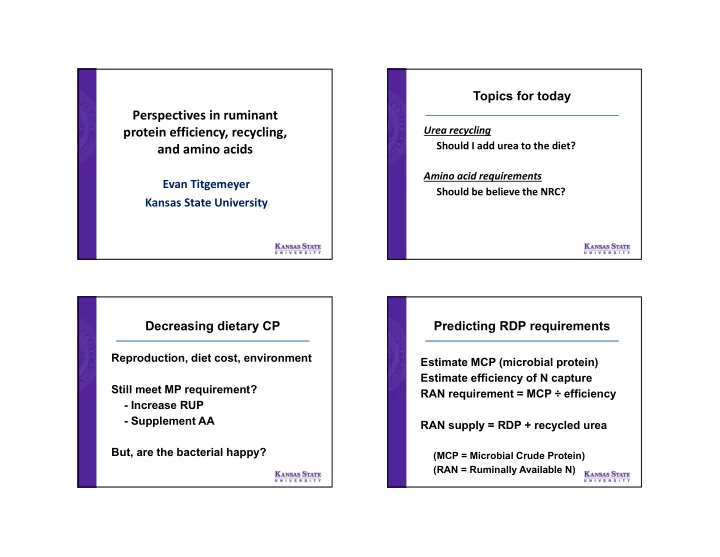

Topics for today Perspectives in ruminant Urea recycling protein efficiency, recycling, Should I add urea to the diet? and amino acids Amino acid requirements Evan Titgemeyer Should be believe the NRC? Kansas State University Decreasing dietary CP Predicting RDP requirements Reproduction, diet cost, environment Estimate MCP (microbial protein) Estimate efficiency of N capture Still meet MP requirement? RAN requirement = MCP ÷ efficiency - Increase RUP - Supplement AA RAN supply = RDP + recycled urea But, are the bacterial happy? (MCP = Microbial Crude Protein) (RAN = Ruminally Available N)
Ruminal Clearance of Urea Urea movement across epithelium Ruminal clearance of urea (L/day) Mucosa Serosa With sucrose Without sucrose VFA (pH 6.2-6.6) + NH 3 Urea Urea - Urease NH 3 Rumen ammonia, mg/L Kennedy, 1980 Lactating dairy cattle Urea supplementation (% of DM) Mucosa Serosa 0 0.4 0.8 Diet CP, % 12.6 13.7 14.9 Urease DMI, kg/d 18.1 18.9 19.0 NH 3 Urea Urea Milk, kg/d 32.7 33.8 34.0 NH 3 NH 3 Milk protein, kg/d 0.90 0.94 0.96 Rumen NH 3 , m M 3.8 6.2 8.2 MCP PUN, m M 3.3 5.5 7.8 Rojen et al., 2011
Dairy cows fed 12.6% CP diet Lactating dairy cattle Liver NH 3 = 105 Diet Urea supplementation (% of DM) RDP = 240 Urea = 113 Nitrogen 0 0.4 0.8 Saliva = 11 N Intake, g/d 366 416 457 ?? 75 Urea Production, g/d 113 174 186 Recycled, g/d 75 104 96 Salivary, g/d 11 16 0 Recycled, % 66 60 52 Urine = 27 Rojen et al., 2011 Rojen et al., 2011 How do we use this MP Requirements information? Target optimal supply of RAN: ‐ NRC (2001) MP requirement = ‐ If we know MCP and ruminally recycled urea, maintenance + milk protein/0.67 then we can calculate the necessary RDP ‐ Estimate of efficiency is key! My perspective: ‐ Efficiency < 0.67 ‐ For most lactation diets, deficiencies in RAN ‐ Efficiency not constant, at least for a are unlikely to exist and certainly not likely to herd be severe
MP Requirements Amino acid utilization 4 3 2 Output 1 NRC 0 0 2 4 6 8 10 12 Input ‐1 ‐2 NRC, 2001 Efficiency of nutrient use Efficiency of MP use in lactating cows (Individuals vs. herds) 90 15% Milk N 23% 80 Nitrogen, g/d 42% 70 Productive N Efficiency = 64% 60 50 40 0 200 400 600 Casein supplementation, g/d Whitelaw et al., 1986
110 Nitrogen 32 100 AA Requirements Retention 90 28 80 70 Plasma 24 60 Lysine 50 20 40 Efficiency of AA use isn’t static 30 20 16 0 3 6 9 12 15 ‐ Energy effects Lysine supplementation, g/d ‐ AA role as anabolic stimulus Lesser affinity Greater affinity Effect of Energy Supply on Methionine Use 26 +Glucose 250 Milk protein secretion +Propionate High energy intake 24 N retention, g/d +Acetate 225 +Fat Efficiency = 21% 200 22 175 Control 20 150 Efficiency = 11% Low energy intake 125 18 100 16 75 0 1 2 3 150 300 450 600 750 Amino acid supply, g/d Supplemental L-Methionine, g/d Schroeder et al., 2006
MP Requirements Efficiency of use varies among AA ‐ Estimates of maintenance and efficiency are correlated with each other Average efficiency of AA utilization for growth 4 ‐ Methionine = 26% (11 trials) ‐ Leucine = 38% (4 trials) 3 ‐ Histidine = 64% (2 trials) 2 Reality Output ‐ Lysine = 47% (3 trials) 1 NRC 0 0 2 4 6 8 10 12 Input ‐1 ‐2 AA Requirements AA Requirements Why hasn’t the 0.67 efficiency ruined the We have a lot to learn! dairy industry? ‐ Empirical observations of responses to ‐ No one uses it as gospel methionine and lysine are useful in predicting times to supplement ‐ Overestimated maintenance requirement balances the underestimated efficiency ‐ At some point, perhaps in 10‐15 years, we’ll have answers on some other amino ‐ MP supply correlated to energy supply acids ‐ We work over a fairly narrow range
Recommend
More recommend